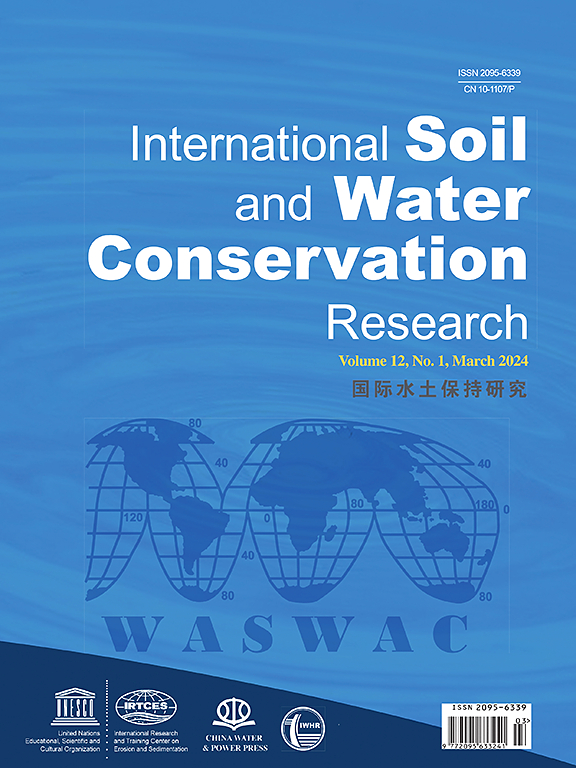冻融过程对东北Mollisol地区结壳、聚集及其与侵蚀面风相互作用的影响
IF 7.3
1区 农林科学
Q1 ENVIRONMENTAL SCIENCES
International Soil and Water Conservation Research
Pub Date : 2025-03-08
DOI:10.1016/j.iswcr.2025.02.010
引用次数: 0
摘要
风蚀被广泛认为是土壤退化的原因之一,而土壤退化又因冻结和解冻的影响而加剧,并对农业生产的可持续性构成严重威胁。从冻融过程对土壤团聚体的影响的角度来看,冻融对Mollisols地区风蚀的影响机制一直是研究的重点。相比之下,物理地壳在冻融效应对风蚀的作用机制中所起的作用仍不确定。为了揭示冻融循环(FTCs)、初始土壤水分(M)等环境条件对团聚体粒径分布、平均重径(MWD)、结皮形成及其性质的影响,以及这些变化对风蚀强度(W)的影响,采用风洞模拟实验测量了4个粒径范围(D)的可蚀性土壤团聚体的风蚀速率。研究了团聚体粒径分布的变化与地壳性质的关系,以及冻结和解冻对团聚体粒径分布的影响。研究结果表明,在冻融循环过程中,团聚体和结壳都容易受到破坏。在第一次冻融循环后,团聚体的MWD表现出显著的变化(p <;0.05)。冻融循环次数与地壳强度之间存在良好的指数相关性(R2 >;0.70)。随着冻融循环次数的增加,地壳强度明显下降。地壳强度变化趋势趋于平缓,地壳强度最小值分别为4.27 kPa (D0.5-1)、2.87 kPa (D0.25-0.5)和2.82 kPa (D <;0.25)超过6次冻融循环。初始含水率对骨料粒度的变化有显著影响,含水率越高,骨料破碎或团聚的变化百分比波动越大。土壤团聚体的解团聚率为12.68% ~ 20.64%,团聚体的再团聚率为0.84% ~ 10.78%。当土壤含水率大于等于12%时,构建的土样表面形成物理结皮,厚度约为1mm。当D≥0.25 mm时,冻融效应是骨料破碎的主要原因,导致MWD减小。当D <;0.25 mm时,主要现象为聚集,导致随钻距增大。当D <;1 mm时,有利于构建土样表面物理结皮的形成。团聚体的脱团聚使风蚀率平均分别提高12.31% (M4%)、12.21% (M8%)、37.15% (M12%)和43.47% (M16%)。相反,再聚集导致风蚀率平均降低20.60% (M4%)、24.22% (M8%)、44.21% (M12%)和34.46% (M16%)。脱团聚过程使团聚体粒径变小,导致相同风速下风蚀损失增大。再聚集过程呈现相反的趋势。结皮显著增强了土壤表面强度,显著降低了风蚀程度,结皮后土壤表面强度分别降低了0.96% (M4%)、14.98% (M8%)、79.15% (M12%)和107.23% (M16%)。虽然在不同的初始土壤水分水平下,构建的土壤样品会形成结皮,但在进行风蚀试验研究之前,所有样品都已自然风干至4%左右。因此,不同的样品湿度水平对阈值风速没有显著的影响。综上所述,我们构建了基于环境条件对风蚀速率影响的路径模型。结果表明,初始土壤水分和冻融效应通过中介团聚体变化、MWD、结皮强度和结皮厚度对风蚀产生间接影响。风蚀速率与表层土壤(2 cm)性质之间的关系显著。初始含水率和冻融效应对风蚀速率的贡献率分别为30.4%和49.2%。本研究阐明了Mollisols地区冻融条件下地壳和团聚体在风蚀影响中的作用,为寒区春季风蚀机理研究提供了科学的理论依据。本文章由计算机程序翻译,如有差异,请以英文原文为准。

The effects of freeze-thaw processes on crusting, aggregation and the interaction with erosive level winds in the Mollisol region of Northeast China
Wind erosion is widely recognised as one of the causes of soil degradation, which is exacerbated by the effects of freezing and thawing, and poses a serious threat to the sustainability of agricultural production. The mechanisms of freeze-thaw effects on wind erosion in the Mollisols region have been the subject of considerable investigation from the perspective of what the impact of freeze-thaw processes have on soil aggregates. In contrast, the role of the physical crust in the mechanism of freeze-thaw effects on wind erosion remains uncertain. In this study, for disentangling the changes in environmental conditions (freeze-thaw cycles (FTCs), initial soil moisture (M)) on aggregate size distribution, mean weight diameter (MWD), crust formation and their properties, and the roles played by these changes in influencing the magnitude of wind erosion (W), a wind tunnel simulation experiment was used to measure the wind erosion rate of erodible soil aggregates with four diameter ranges (D). The relationship between the variations in the distribution of aggregate sizes and the properties of the crust, as well as the impact of freezing and thawing on the distribution of aggregate sizes, were examined. The findings indicated that both aggregates and crust were susceptible to damage during the freeze-thaw cycle. The MWD of the aggregates exhibited a notable alteration following the 1st freeze-thaw cycle (p < 0.05). There exists a good exponential correlation between the strength of the crust and the number of freeze-thaw cycles (R2 > 0.70). The crust strength demonstrated a decline significantly with an increase in the number of freeze-thaw cycles. The variation tendency of crust strength tended to be flat and towards a minimum crust strength of 4.27 kPa (D0.5–1), 2.87 kPa (D0.25–0.5), and 2.82 kPa (D < 0.25) beyond 6th freeze-thaw cycles. The initial moisture content had a significant impact on the variation in aggregate sizes, with higher moisture leading to greater fluctuations in the variation percentage of aggregates breaking or aggregating. The percentage of de-aggregation (disintegration of soil aggregates) varied from 12.68% to 20.64%, while the percentage of re-aggregation (recombination of soil aggregates) varied from 0.84% to 10.78%. When the moisture content of the soil was greater than or equal to 12%, a physical crust formed on the surface of the constructed soil samples, with an approximate thickness of 1 mm. When D ≥ 0.25 mm, the freezing-thawing effect was the primary cause of aggregate breakage, resulting in a reduction in MWD. When D < 0.25 mm, the primary phenomenon was aggregation, which resulted in an increase in MWD. When D < 1 mm, the formation of a physical crust on the constructed soil sample surface was facilitated. De-aggregation of aggregates increased the wind erosion rate by an average of 12.31% (M4%), 12.21% (M8%), 37.15% (M12%) and 43.47% (M16%) respectively. Conversely, re-aggregation led to a reduction in wind erosion rate by an average of 20.60% (M4%), 24.22% (M8%), 44.21% (M12%) and 34.46% (M16%), respectively. The process of de-aggregation makes the aggregate size smaller, leading to an increase in wind soil erosion losses at the same wind speed. Re-aggregation process showed the opposite tendency. The formation of a crust greatly enhanced the soil surface strength and significantly reduced the degree of wind erosion, which decreased by 0.96% (M4%), 14.98% (M8%), 79.15% (M12%) and 107.23% (M16%), respectively, after crust formation. Although the constructed soil samples formed crusts under different initial soil moisture levels, all samples had naturally air-dried to approximately 4% prior to the wind erosion experimental study was conducted. Therefore, there was no significant change in threshold wind velocity due to different sample moisture levels. In conclusion, we constructed a path model based on the effects of environmental conditions on the wind erosion rate. The results indicated that the initial soil moisture and freeze-thaw effect exerted an indirect influence on wind erosion, by mediating their impact on aggregate variation, MWD, crust strength and crust thickness. The relationship between wind erosion rate and topsoil (2 cm) properties was significant. The initial moisture content and the freeze-thaw effect contributed 30.4% and 49.2%, respectively, to the rate of wind erosion. This study clarifies the role played by the crust and aggregation in the influence of wind erosion under freeze-thaw conditions in the Mollisols region, and provides a scientific theoretical basis for the mechanism of spring wind erosion in cold regions.
求助全文
通过发布文献求助,成功后即可免费获取论文全文。
去求助
来源期刊

International Soil and Water Conservation Research
Agricultural and Biological Sciences-Agronomy and Crop Science
CiteScore
12.00
自引率
3.10%
发文量
171
审稿时长
49 days
期刊介绍:
The International Soil and Water Conservation Research (ISWCR), the official journal of World Association of Soil and Water Conservation (WASWAC) http://www.waswac.org, is a multidisciplinary journal of soil and water conservation research, practice, policy, and perspectives. It aims to disseminate new knowledge and promote the practice of soil and water conservation.
The scope of International Soil and Water Conservation Research includes research, strategies, and technologies for prediction, prevention, and protection of soil and water resources. It deals with identification, characterization, and modeling; dynamic monitoring and evaluation; assessment and management of conservation practice and creation and implementation of quality standards.
Examples of appropriate topical areas include (but are not limited to):
• Conservation models, tools, and technologies
• Conservation agricultural
• Soil health resources, indicators, assessment, and management
• Land degradation
• Sustainable development
• Soil erosion and its control
• Soil erosion processes
• Water resources assessment and management
• Watershed management
• Soil erosion models
• Literature review on topics related soil and water conservation research
 求助内容:
求助内容: 应助结果提醒方式:
应助结果提醒方式:


